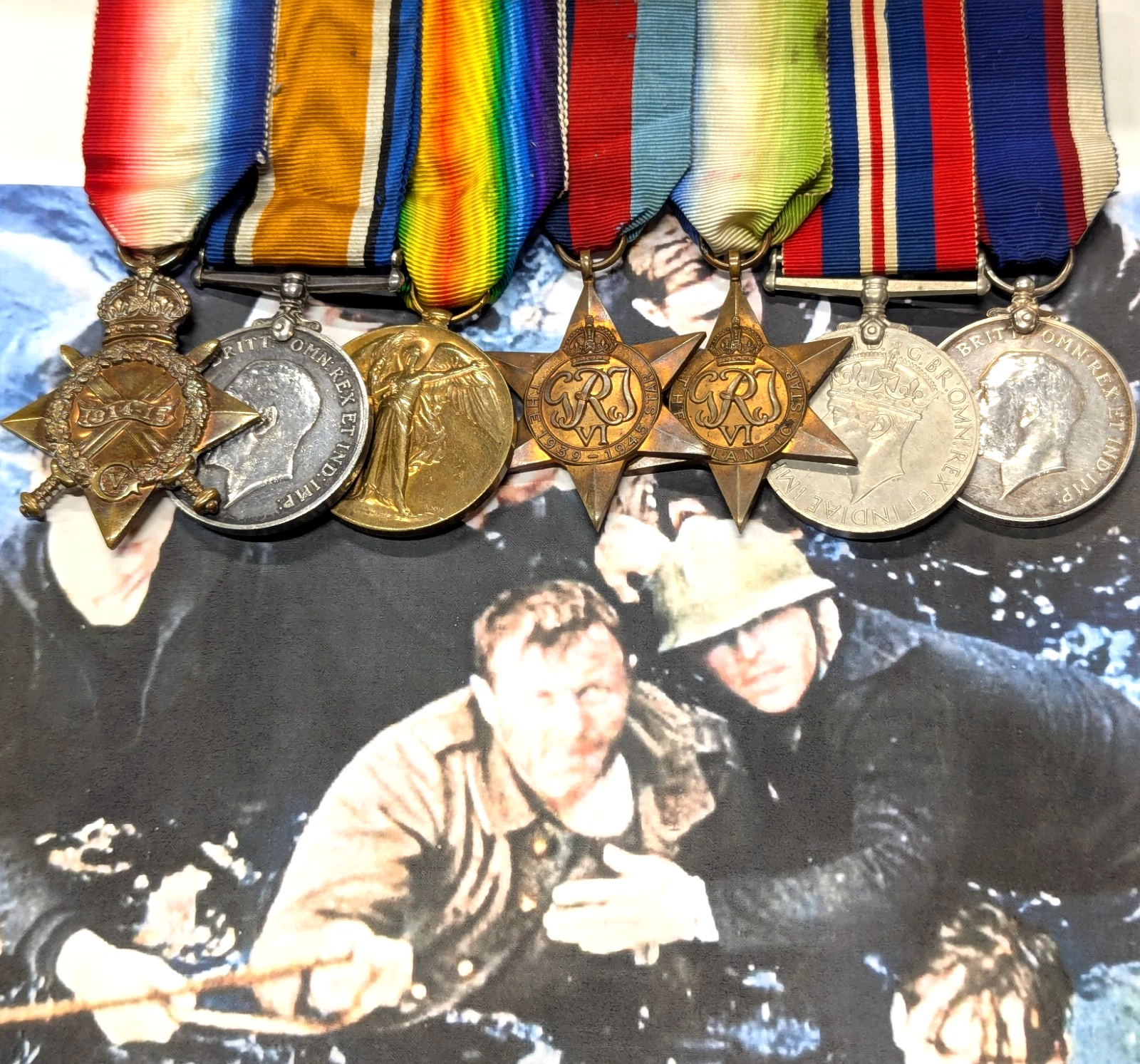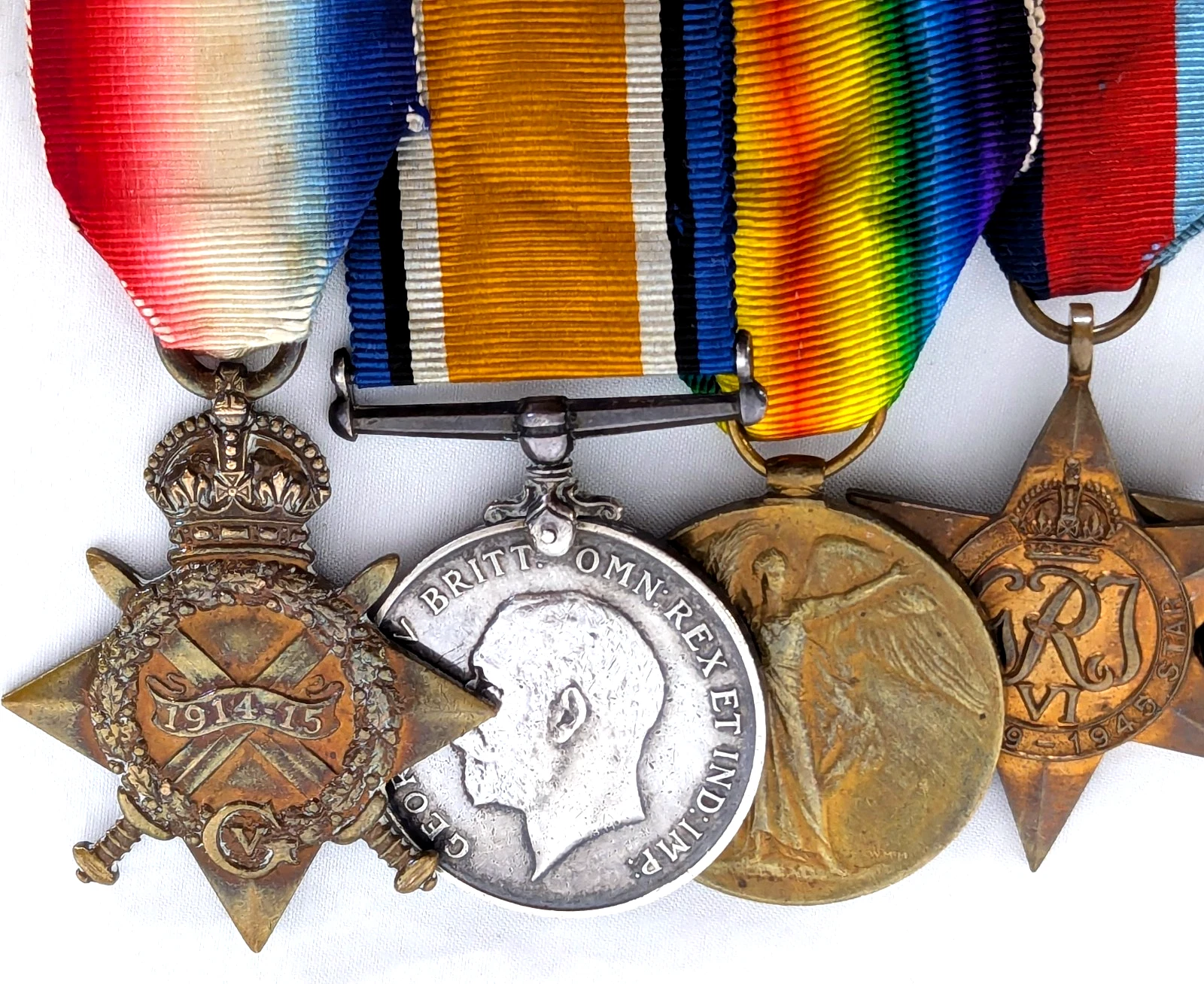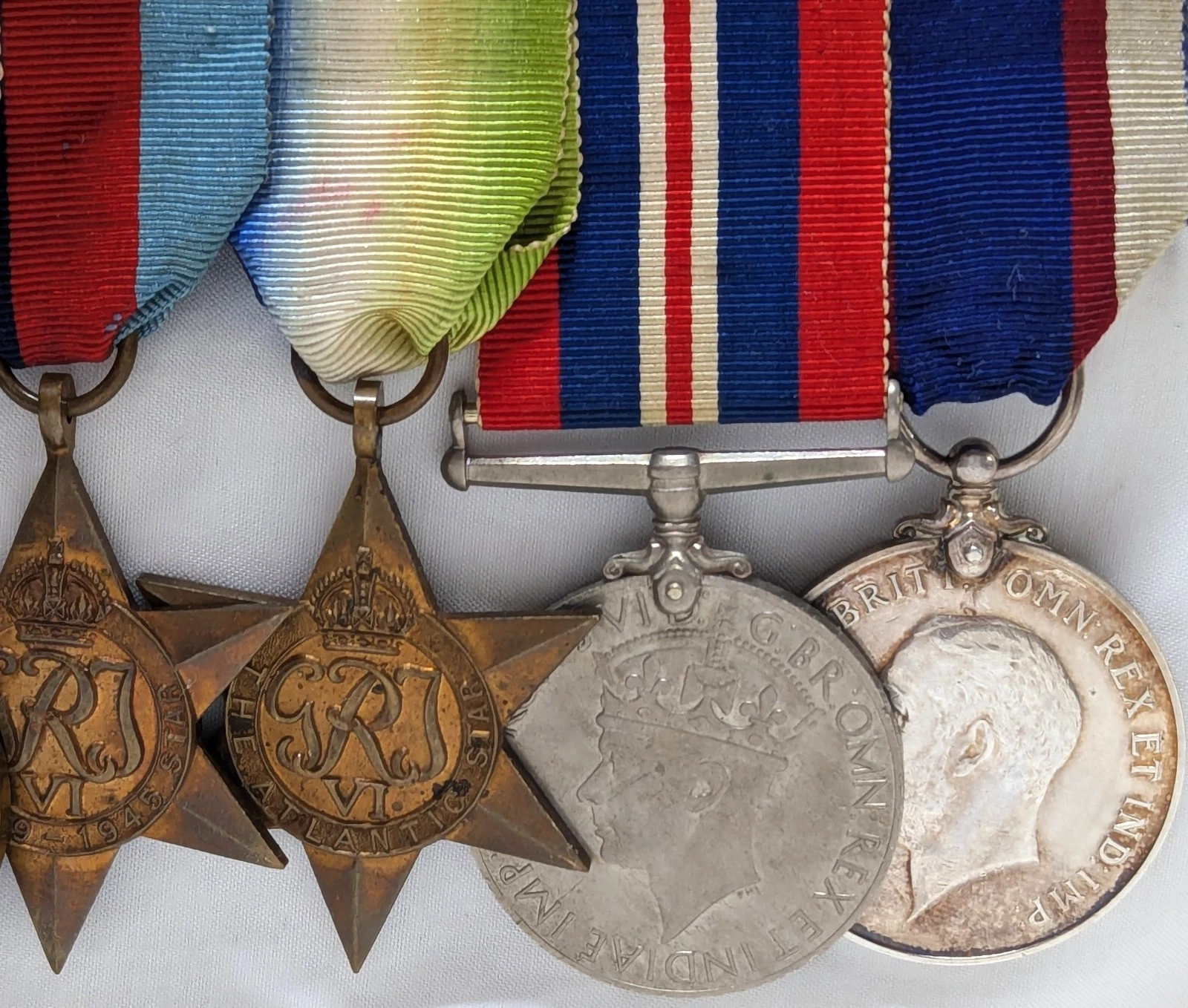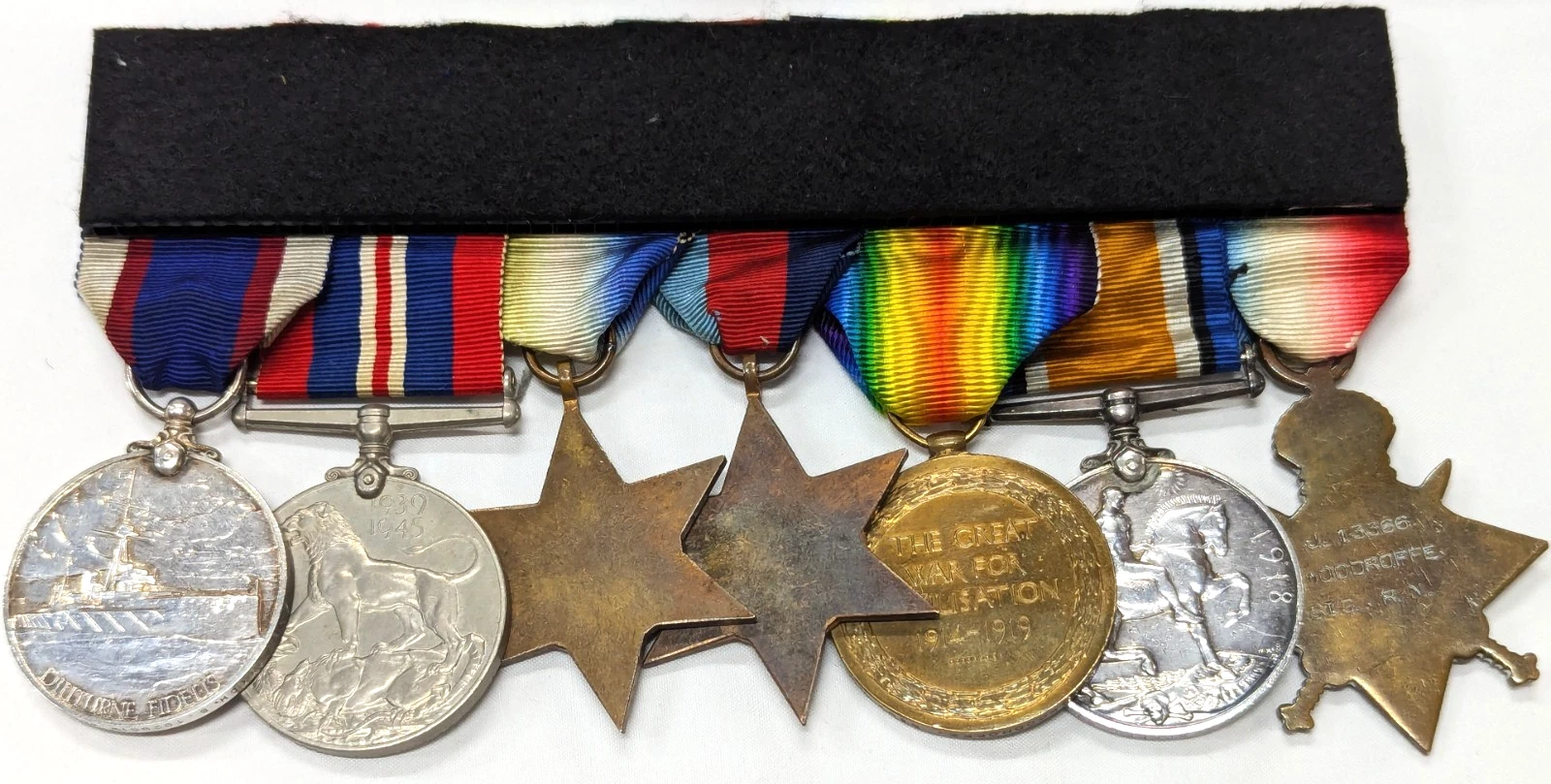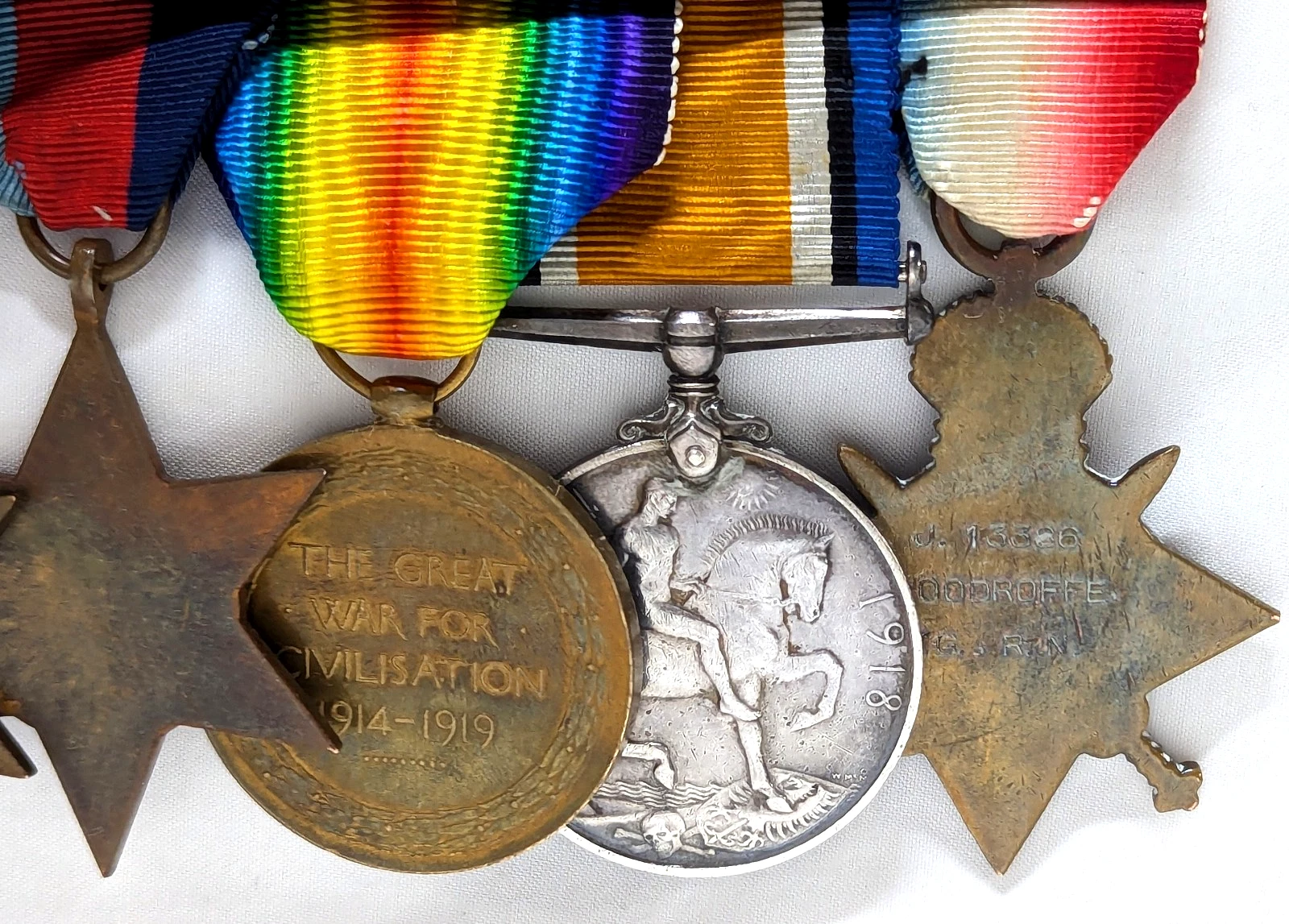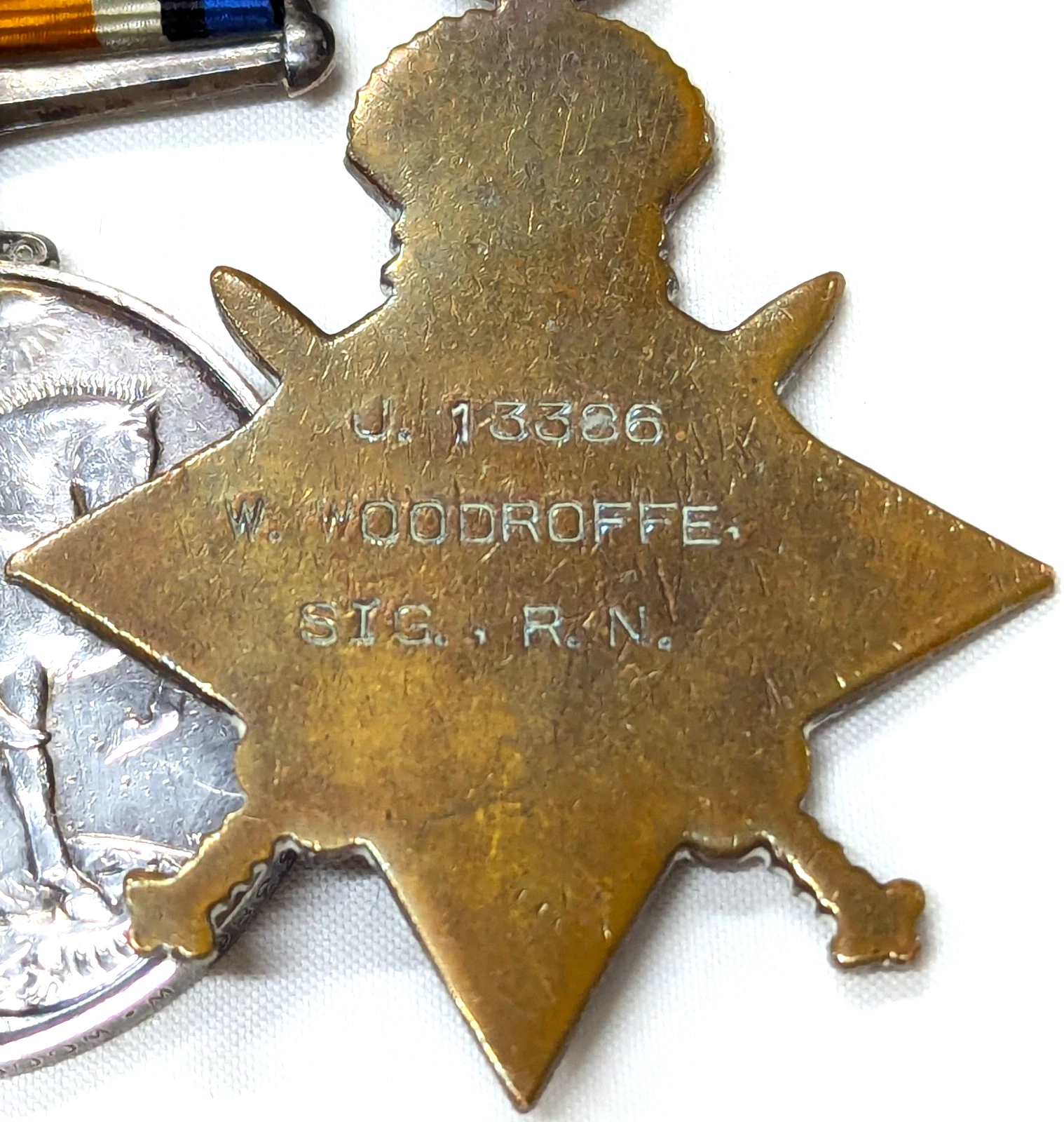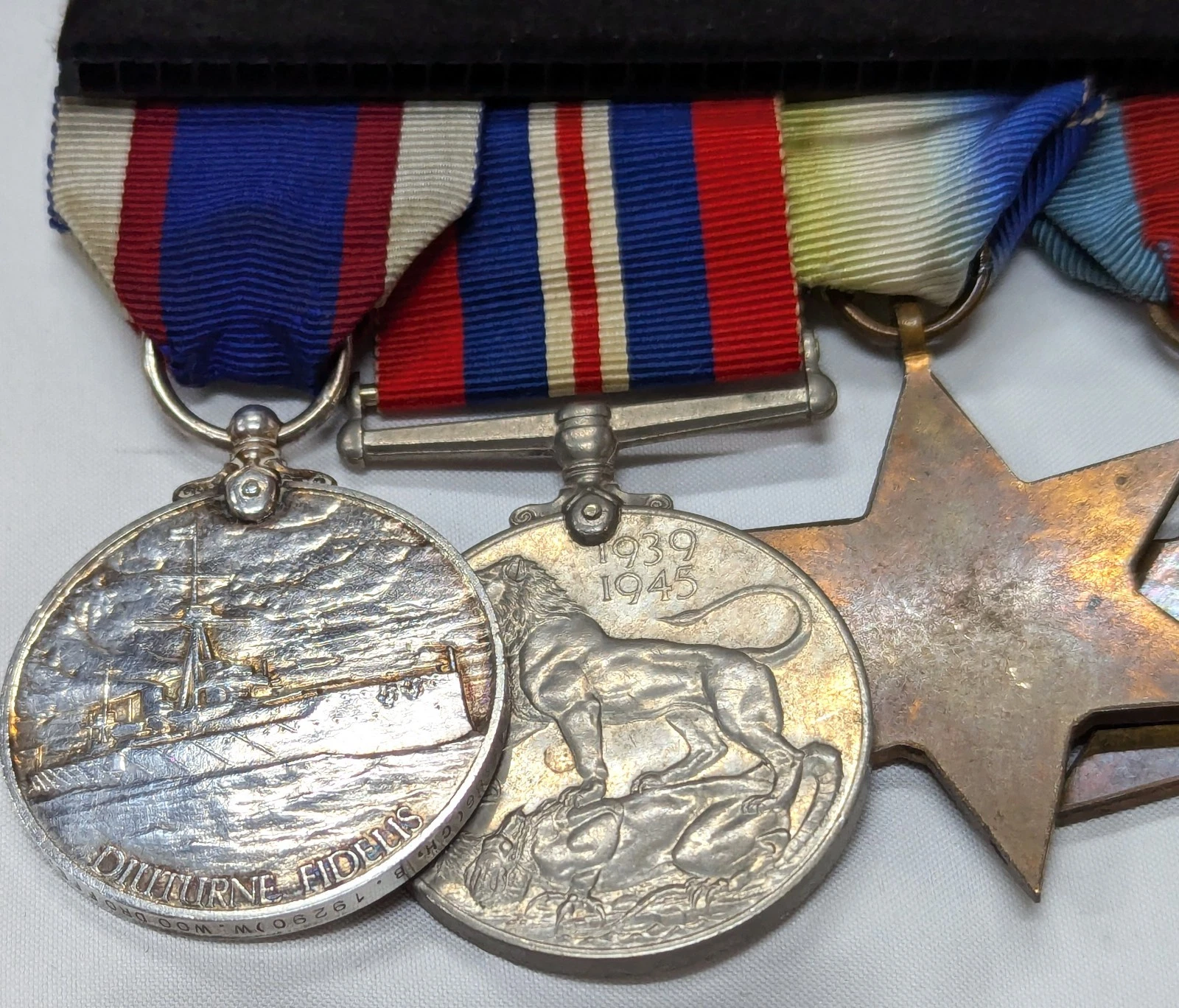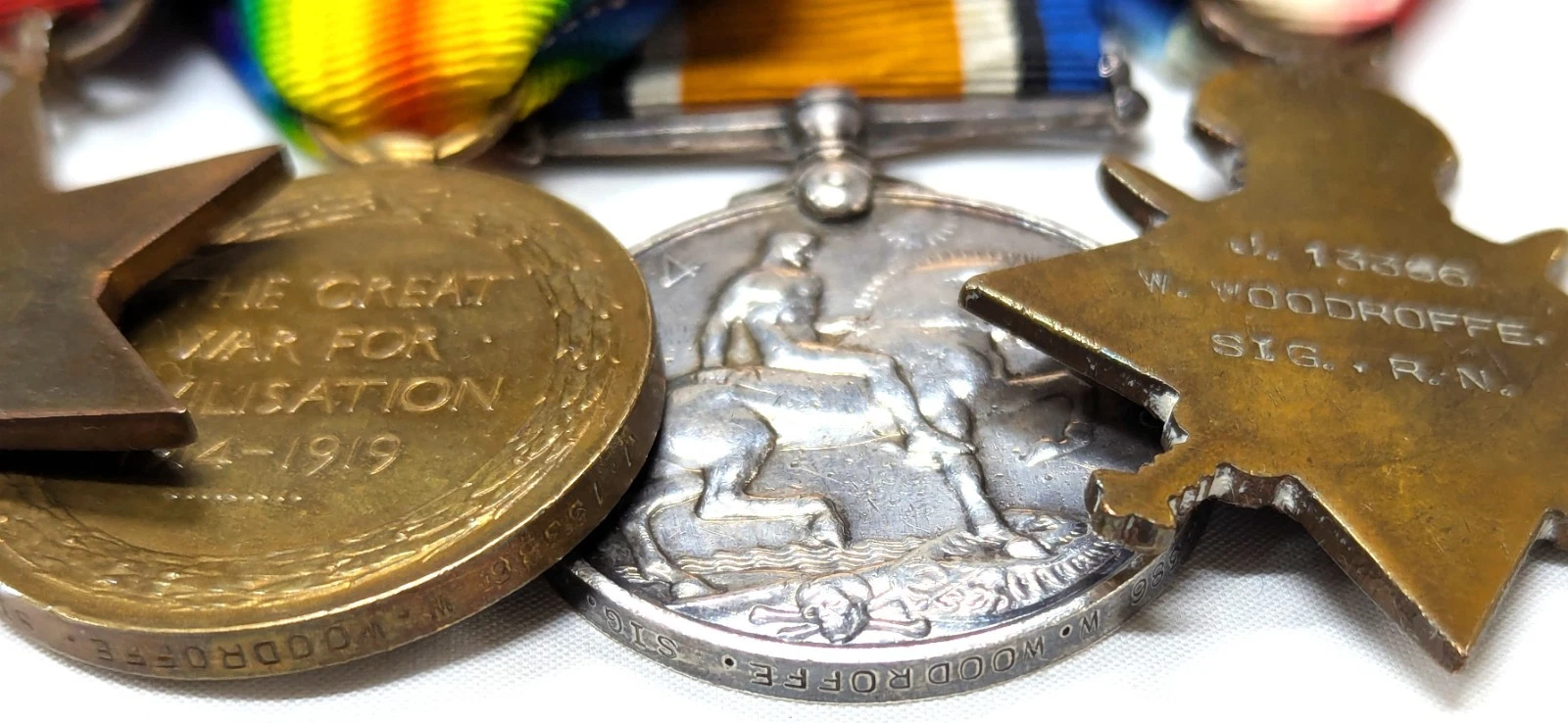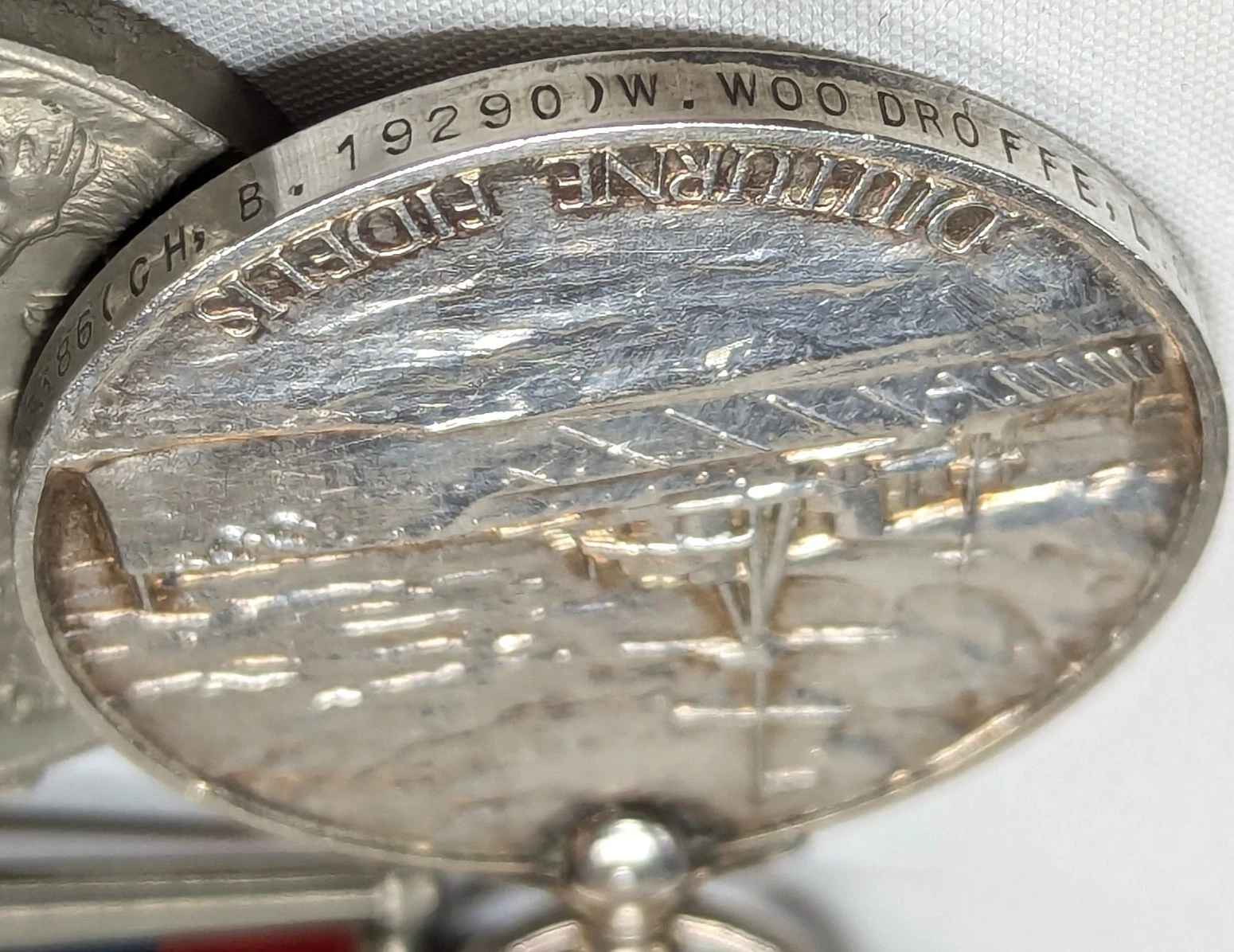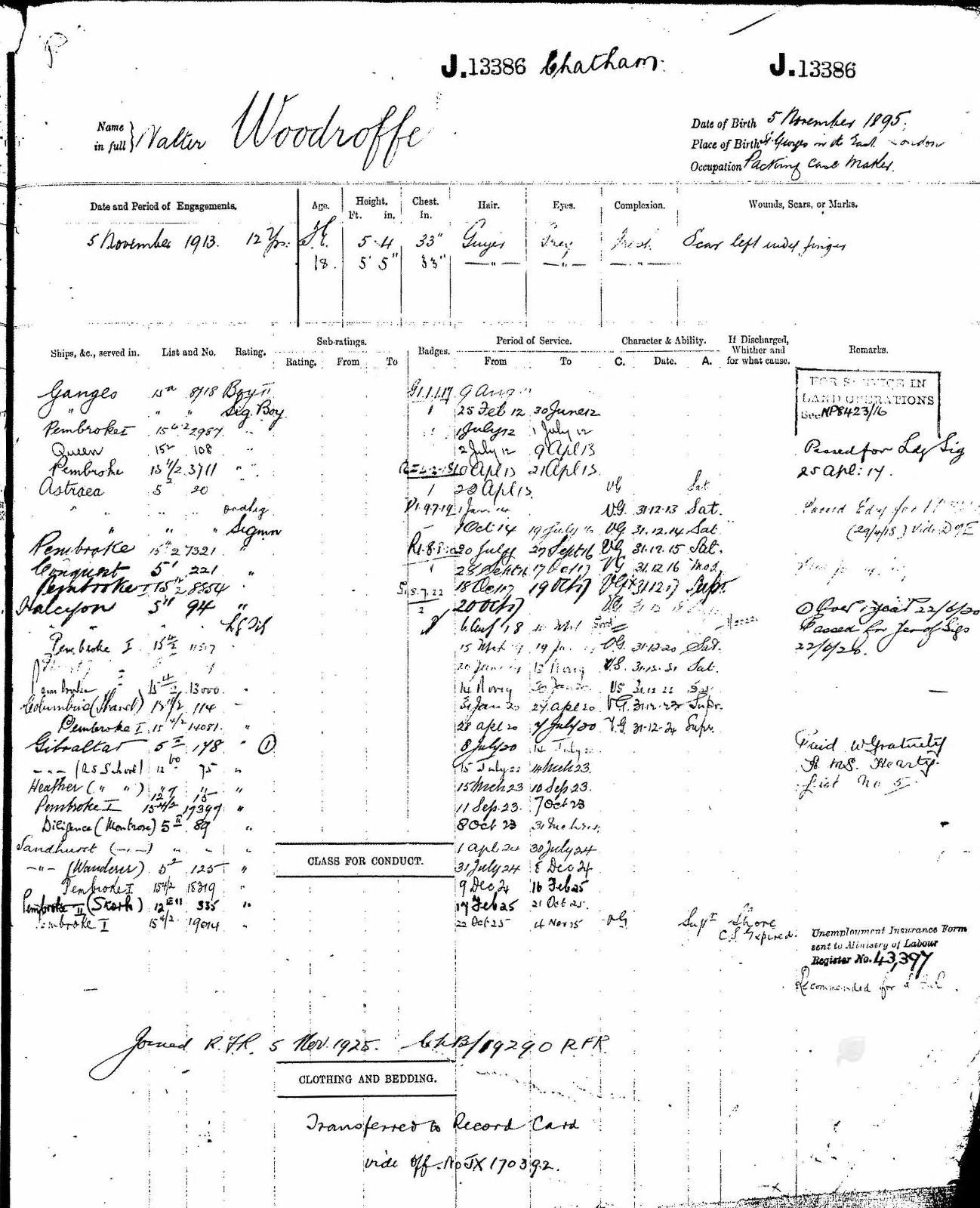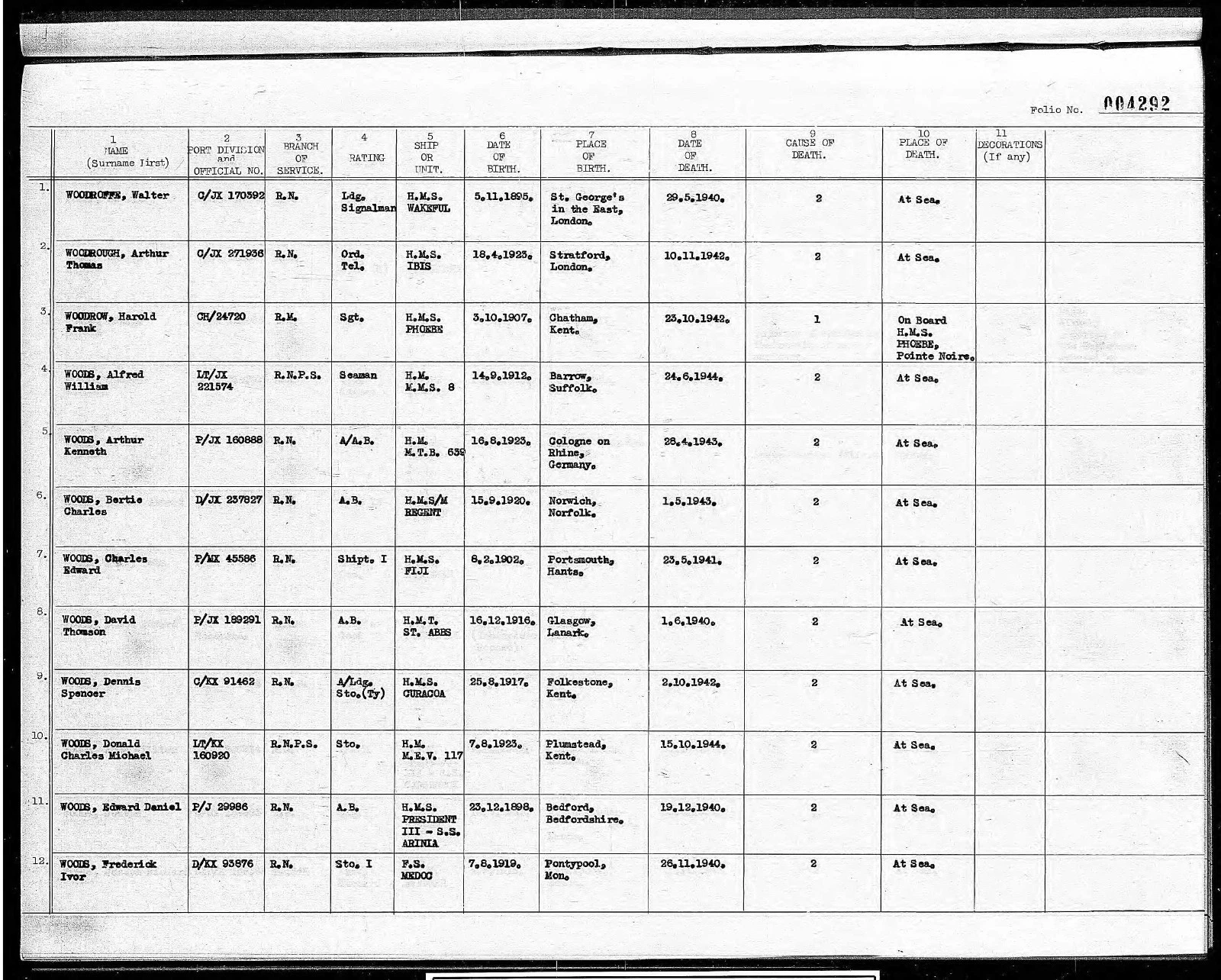WW1 & KIA Dunkirk WW2 medals to Leading Signaller Woodroffe HMS Wakeful navy RN
$950.00
SOLD
A poignant Great War and Second World War campaign group of seven awarded to Leading Signalman W. Woodroffe, Royal Navy, who was killed in action whilst serving in H.M.S. Wakeful off Dunkirk on 28 May 1940.
In harrowing scenes reminiscent of those depicted in Christopher Nolan's award winning film 'Dunkirk', Wakeful was taken out by an E-Boat torpedo strike, broke in two, and went down within a minute, taking with her some 640 embarked Allied troops and most of her crew.
1914 – 15 Star named J13386 W. WOODROFFE. SIG. R.N.; British War and Victory Medals named J.13386 W. WOODROFFE Sig. R.N.; 1939 – 45 Star, Atlantic Star, War Medal all unnamed as issued.; Royal Fleet Reserve Long Service & Good Conduct (G.V.R.) named J.13386 (Ch. B.19290) W. WOODROFFE. L. Sig., R.F.R. Swing mounted and come with copies of service record, medal roll and casualty extract.
Leading Signaller Walter Woodroffe was born in St. Georges, East London in 1895. A packing case maker by trade he enlisted into the Royal Navy as a Signal Boy 2nd Class on 25/2/1912.
On the outbreak of the Great War, he was serving on HMS Astraea (cruiser) 22/4/1913 - 19/7/1916. She was serving off East Africa and on 8/8/1914 bombarded Dar-es-Salaam, part of the German colony of German East Africa. She destroyed a radio station, and fearing an imminent landing, the German authorities scuttled their floating dock to block the harbour. This had the subsequent effect of preventing the German commerce raider S.M.S. Königsberg from being able to return to the port. She remained in the area assigned to hunt and blockade Königsberg in the Rufiji Delta.
In May 1915 Astraea provided a support role during the invasion of Kamerun, Woodroffe's service record noting he participated in land operations as a Bluejacket.
Posted to H.M.S. Conquest (light cruiser) from 28/9/1916 – 17/10/1917, it was during this time on 5/6/1917, that she and the 2 other light cruisers sank the German torpedo boat S20 in the North Sea off Zeebrugge. Posted to H.M.S. Halcyon (paddle minesweeper) he served on her from 20/10/1917 to the wars end.
He remained in the R.N. until discharging to shore time expired on 4/11/1925 as a Leading Signaller and into the Royal Fleet Reserve. At a later date his service # was changed to JX170392.
Recalled for WW2 he was serving on HMS Wakeful (destroyer) he was killed in action on 29/5/1940 during Operation Dynamo.
On 27/5/1940 Wakeful embarked 631 Allied troops and while returning to Dover she came under air attack and received minor damage below the waterline. Despite the near miss, she returned to Dunkirk to continue the evacuation, embarking 640 Allied troops on 28/5/1940. The Wakeful was torpedoed by the German E-Boat S-30 being struck by two torpedoes, one hitting the forward boiler room. Casualties were heavy, only four of the 640 soldiers and 25 of the crew survived. A number of ships stopped to pick up the survivors, but one of these, the destroyer Grafton, was then in turn sunk by a German U-boat.
Fisher, who retired as a Rear-Admiral, later wrote about Wakeful's loss in his autobiography, Salt Horse, A Naval Life:
'We anchored off Braye Sanatorium, unable to get nearer than about a quarter of a mile from the beach on which long queues of soldiers were waiting. It was comforting to be in company with plenty of friendly vessels including, next door to us, the new destroyer Jaguar with much better ant-aircraft armaments than Wakeful. However, there was low cloud and rain that afternoon and bombing attacks were few and ineffective but getting the troops onboard was painfully slow. Our boat would row into the beach only to be swamped by eager troops and immovably grounded. There were other boats about but they tended to be abandoned by soldiers who had finished with them and let them drift away. During some eight hours we got about 640 troops onboard and sailed after dark.
Wisely - or perhaps unwisely as it turned out - I had insisted that all troops should be stowed as low as possible so as to preserve stability in case we should have to manoeuvre at high speed to avoid bombs. At fifteen men to the ton 600 men constituted a serious top weight consideration in a ship the size of Wakeful. Accordingly, they were stuffed into engine room, boiler rooms and storerooms. The route this time was by Zuydcootte Pass, where I felt our propellers hitting the sand and then up to Kwinte Buoy where one would turn west for Dover. So as not to reveal ourselves to aircraft by a bright wake we went at only 12 knots until we neared the Kwinte Buoy, where any enemy might be lurking, and then increased to 20 knots with a wide zigzag. Phosphorescence was very bright.
The buoy was brightly flashing once a second and, when it was about a quarter of a mile on our starboard bow, I saw two tracks like white swords coming towards us from that direction. We avoided one but the other torpedo hit us on the forward boiler room with, I remember, a brilliant white flash. It transpired after the war that these torpedoes were fired by Lieutenant Zimmerman from E-boat S-30, hiding behind the brightly flashing buoy. A well-planned attack and a good shot. Wakeful was cut in two and the halves sank immediately until their broken ends grounded on the bottom, the forepart rolled over to starboard and it cannot have been more than 15 seconds before I found myself swimming off the bridge.
There were perhaps fifty of my men, probably gun crews, in a group in the water with me. All my engine room people had been killed and all except ten of the soldiers trapped inside the ship and tragically drowned. The tide was quickly sweeping our group away from the grounded wreck and we must have been a mile or two down-tide when two Scottish wooden fishing boats on their way to Dunkirk came amongst us. The Nautilus picked up six, including my first lieutenant, and the Comfort sixteen, including myself. We tried for about half an hour to pick up others we could hear shouting in the dark but it was terribly slow work hauling out sodden half-drowned men. Eventually the shouting stopped.
The Nautilus went on to Dunkirk and I directed the skipper of the Comfort to go up-tide to the wreck, where I had last seen men sitting on the stern portion some forty feet above the water. When we got there we found the destroyer Grafton lying stopped with her boat over at the wreck. The Grafton's deck was solid with soldiers and I went alongside her starboard quarter to tell her captain to get out of it as there were enemy about. At that moment some sort of grenade exploded on her bridge and he was killed. Nobody seems to know what this was. At the same time there was a large explosion as a torpedo hit the Grafton on the opposite side from where Comfort was lying.
Wakeful had survived twenty-seven bombing attacks before 26-year-old Overlieutenant zur See Willem Zimmerman's S-30 had caught her with a single torpedo. Casualties had been heavy: a hundred of the crew were lost and 640 soldiers … '
Woodroffe, who was among those casualties, is commemorated on the Chatham Naval Memorial.
Additional information
| Weight | 0.5 kg |
|---|---|
| Dimensions | 30 × 30 × 5 cm |
